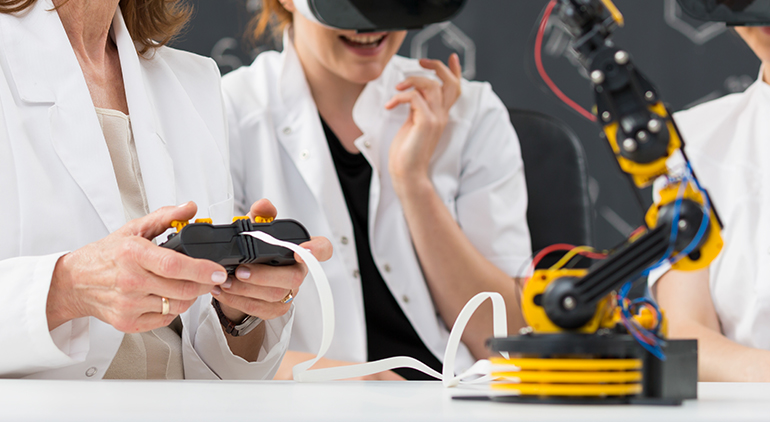Innovative Education Through Virtual Machines

Tech advancement, easy accessibility, and increased affordability of VR devices is driving a mammoth change in the education sector. This is particularly true VR for higher education.
Remote learning is expanding, virtual reality adoption is skyrocketing, and virtual labs will become a sine qua non in the recent future. This is evident from research published by Allied markets Research.
The virtual training and simulated labs market were at a valuation of $204.41 Billion in 2019. By 2027, the market is expected to reach $601.85 Billion.
The CAGR exhibited by the market will be 13.7% from 2019 to 2027.
The immersive environment that can be created using virtual reality labs is proving to be an innovative and productive teaching method. The students can experience the subtleties and intricate workings of an actual lab. They can experiment with the variables and components.
The biggest attraction is that all this is possible without any actual repercussions that might arise due to faulty handling. VR is also a one-time investment for the institutions and various labs and machines can be incorporated into the environment without significant additional expenditures.
To get a better understanding of the advantages, here we will discuss two virtual machines. We will also glance at the tech requirements needed for a smooth VR adoption.
These use cases will give you better clarity about the unique benefits that integrating VR can bring for your institution’s curriculum.
Examples of Virtual Machines
1. Trenching Machine
Chain trencher is earthmoving equipment. It is crucial for civil engineers to acclimatize themselves with the working of this machine. It is similar to an excavator and can save hours of digging time.
Being a large machine equipped with high-strength steel rippers, the working and components of the machine are currently taught through videos or simple diagrams.
Virtual reality chain trencher is an example of innovation in teaching and learning. The benefits are as follows:
The 3D module is created through extensive research and inputs from industry experts.
The immersive environment allows the learners to familiarize themselves with the minutes of components. They can interact and understand the importance and applications of modules like slider mechanism, back skid, tooth chain, and drive motor.
The dismantled view allows the learners to understand what is within the machine. This helps in cultivating a deeper understanding of the working. This is not possible if the teaching medium is simply a diagram, a video, or even if a chain trencher is actually given to the student.
Through various text boxes and guides that appear on the screen, the student can have a meaningful experience that adds to the interaction.
2. Petrol Engines
Understanding petrol engines is crucial to a wide array of engineering education like mechanics and automobiles. Though the engine is relatively simpler to acquire, it is not possible to understand the cross-sectional nuances of the machine in detail.
Virtual reality comes with the solution. Let us take a look at some benefits:
VR enables the institution to present real-scale petrol engines.
The virtual artifact is created by replicating real-world machines and taking insights from experts.
Through VR, the student can experience an x-ray model of the engine. This helps in familiarizing with the internal workings of the engine along with the outputs and visible mechanisms.
The immersive virtual reality better learning environment allows the learner to interact with engine parts like the engine block, pistons, cylinder head, crankshaft, camshaft, valves, and oil pans.
The learner can also get a cross-sectional view of all the components and the guided session will inculcate a deeper understanding of each and every parts of the engine from the body to the smallest units.
The virtual training and simulated labs market is seeing an exponential adoption rate owing to these benefits. The convenience is two-fold. The students can understand potentially hazardous industrial situations and large-scale machines in a safe and personalized environment.
And the institution can provide access to real-life scenarios and industry-grade equipments (most of them too costly to acquire) in a feasible and practical manner. Let us conclude by understanding the tech integrations needed for this inevitable innovation in teaching and learning that is being fuelled by virtual machines?
Conclusion
For 3D visualizations and getting an immersive environment set up, the following components are mandatory:
A stereoscopic device for enhancing binocular perception.
HMD. This can be smartphone-powered HMD for remote learning or a tethered and standalone HMD for the virtual labs within the institution.
An immersive room or CAVE to get the students completely immersed in the experience.
A multi-screen power wall is optional but can add to the experience by promoting teamwork among the learners.
The cost-effective benefits of virtual labs are driving the adoption within this sector. Though the hardware segment is showing current domination, the software segment is expected to experience significant growth by 2027 (according to Allied Markets Research)
At iXR Labs, we dream of a future where immersive education will be the norm. Our cutting-edge tech and industry-specific use cases can show you the potential of VR in higher education. To know more, visit www.ixrlabs.com.




